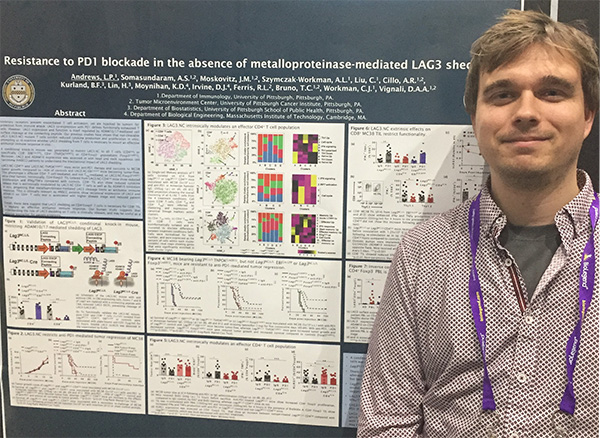
Congratulations – Jackson ImmunoResearch catches up with the latest travel grant recipient at AAI 2019
Jackson ImmunoResearch continues to offer travel funding to support researchers attending academic meetings and conferences.
JIR invited applications from attendees of the American Association of Cancer Research 2019 conference in Atlanta Georgia to receive a travel award of $1,000 to be used against costs incurred to attend meeting. Our selected winner was unable to attend AACR 2019, so we caught up with him at AAI 2019 instead.
Travel award winner 2019

Our latest travel grant recipient is Lawrence Andrews, who is a Postdoctoral Associate at the University of Pittsburgh. JIR caught up with him at AAI 2019.
Lawrence Andrews is the latest recipient of the JIR Travel grant. He is a Postdoctoral Associate in the Department of Immunology at the University of Pittsburgh.
“My research interests revolve around an inhibitory receptor called LAG3, which is currently the third checkpoint molecule to be targeted in the clinic. This follows the success of PD1 and CTLA4 blocking agents that have improved objective response rates for a variety of tumor types, some of which have been previously difficult to treat. However, the majority of patients do not respond to current anti-PD1 immunotherapeutic regimens and our data from preclinical models show that dual target of both PD1 and LAG3 inhibitory receptors results in enhanced antitumor immune effects resulting in the complete remission of tumors. Our future directions aim to dissect the mechanistic roles that both PD1 on LAG3 has on different immune cell populations that infiltrate the tumor microenvironment, to understand the resistance mechanisms that LAG3 plays in patients who are non-responsive to PD1 blockade.”
Attending AAI 2019
“The AAI annual meeting was a great opportunity for myself to interact with renowned investigators and trainee scientists, through listening to amazing talks by established immunological rock-stars and their enthusiastic grad students. Presenting a poster at this meeting allowed me to discuss my research, not just with colleagues within my field of cancer immunotherapy, but also allowing me to engage with other researchers that have different niches and expertise across the broad landscape of immunology. Such exposure has allowed myself to think about my project with a different perspective, in order to take my research in a new and exciting direction, with scientific knowledge that I may have not fully appreciated before. The amazing social events at the AAI annual meeting, in particular, the Immunology Gala on the flight deck of the USS Midway, has allowed me to form many friendships with new colleagues that will be important for my professional scientific development in the future. Thank you, Jackson Immunoresearch, for the travel award that allowed me to attend AAI 2019 in San Diego!”
Poster

Resistance to PD1 blockade in the absence of metalloproteinase-mediated LAG3 Shedding
Targeting PD1 with monoclonal antibodies has yielded clinical success across a variety of tumor types, yet overcoming inhibitory receptor (IR)-mediated tolerance is essential to improve immunotherapeutic responses. LAG3 co-expresses with PD1 on CD8+ tumor-infiltrating T cells (TIL), signifying a highly exhausted phenotype, and dual PD1/LAG3 blockade in C57BL/6 mice enhances antitumor immunity. As CD8+ TIL is the highest LAG3-expressing TIL population, it is hypothesized that PD1 and LAG3 synergize to limit CD8+ TIL function controlling antitumor immunity.
To understand the cellular and mechanistic basis for PD1/LAG3 synergy, conditional knock-in mice “surgically dissect” Pdcd1 and/or Lag3 floxed alleles restricted to CD8+ T cells expressing E8ICre.GFP. B16-F10 melanoma was utilized to understand how PD1 and LAG3 on CD8+ T cells mechanistically control tumor growth.
Whilst Pdcd1L/L E8ICre.GFP and Lag3L/L-yfp E8ICre.GFP mice show attenuation of B16-F10 tumor growth, this is further enhanced in Pdcd1L/L Lag3L/L-yfp E8ICre.GFP mice with improved survival. CD8+ TIL frequency is increased with loss of PD1 and LAG3 due to enhanced proliferation (Ki67/BrdU). Whilst PD1/LAG3-deficient CD8+ TIL have increased IFNg and GzmB release by flow cytometry, utilizing a 28-plex single-cell cytokine response panel shows polyfunctionality was greatly enhanced and was largely driven by effector and chemoattractive secretion.
Although expression of TIM3, TIGIT and 2B4 IRs that normally co-express with PD1 are maintained to compensate for PD1/LAG3 loss, expression of NKG2A is completely diminished on CD8+ TIL of Pdcd1L/L Lag3L/L-yfp E8ICre.GFP (but not Pdcd1L/L E8ICre.GFP) mice, suggesting that LAG3 uniquely regulates the CD94/NKG2A pathway that may facilitate CD8+ T cell exhaustion in this model.
Overall PD1 and LAG3 on CD8+ TIL limit antitumor immune effects as deletion of both IRs results in reduced B16-F10 tumor growth with enhanced CD8+ TIL polyfunctionality, suggesting that the development of LAG3 targeting agents in the clinic would yield improved responses with anti-PD1.
LAG3 (CD223) as a cancer immunotherapy target
Lawrence P. Andrews Ariel E. Marciscano Charles G. Drake Dario A. A. Vignali
There are still further opportunities to apply for JIR’s 2019 travel grants for selected conferences here!
| Learn more: | Do more: |
|---|---|
| Direct and indirect Western blotting | Exhibition schedule |
| Choosing your secondary antibody | NIR conjugates for Western Blotting |
| Colorimetric Western blotting | Cite and win! |


